Best Cloud Computing Software
Cloud computing is an on-demand delivery of a virtual environment that includes pool of resources, such as compute, storage, applications, database, and network, through pay-as-you-go pricing service models which enable enterprises to host their workloads. The Cloud Computing Market is driven by increased automation and agility and the need for delivering enhanced customer experience.
Going further, the market presents a lot of opportunities due to a rise in number of SMEs to create new revenue opportunities for cloud vendors and an increase in adoption of hybrid cloud services.
Top 10 Cloud Computing Software Vendors
- AWS
- IBM
- Microsoft
- Oracle
- Alibaba
- SAP
- VMWare
- Rackspace
- Salesforce
Market Overview
Cloud computing helps enterprises use remote servers hosted on the internet to store, manage, and process the critical data. The increasing volume of data generation in websites and mobile apps, rising focus on delivering customer-centric applications for driving customer satisfaction, and growing need to control and reduce Capital Expenditure (CAPEX) and Operational Expenditure (OPEX) are a few factors driving the growth of the emerging technologies.
The emerging technologies, such as big data, Artificial Intelligence (AI), and Machine Learning (ML) are gaining traction which is ultimately leading to the growth of the cloud computing market, globally. Moreover, major factors, such as data security, faster Disaster Recovery (DR), and meeting compliance requirements are driving the growth of cloud computing services. Additionally, the need to mitigate risks, achieve scalability and flexibility to move and store data, reduce storage and infrastructure complexities, and increase business efficiency are leading to the growth of the cloud computing market.
Cloud computing enables businesses to use applications and other resources, such as servers and databases, managed by third-party companies that are stored in high-end server computers and networks. Cloud offers self-service provisioning, enhanced performance and productivity, and increased speed. To adhere to these benefits, businesses may choose service models completely dependent on business requirements.
The Software-as-a-Service (SaaS) model has the highest adoption rate currently owing to various advantages, such as no need to manage, install, or upgrade the software because SaaS providers handle these tasks by themselves, equipment failure does not result in loss of data, and easy and on-demand access of applications. On the other hand, the Platform-as-a-Service (PaaS) model offers a platform for developing and deploying software. It provides various advantages of simple and cost-effective development and deployment, automated business policies, and easy migration to hybrid models. The Infrastructure-as-a-Service (IaaS) model offers highly scalable and automated compute resources. It offers advantages of automated deployment of storage, networking, servers, and processing power; and high flexibility and scalability.
Competitive Scenario
The cloud computing market is growing at a rapid rate across all regions. To gain more market share and ensure a better market position, vendors and players are adopting several growth strategies, some of which are highlighted in the figure given below. The strategies adopted by the major players primarily revolve around new product launches; mergers and acquisitions; and partnerships, agreements, and collaborations with other market players. In addition to this, the competitive landscape studies the key growth strategies adopted by the market players between 2015 and 2019 to expand their presence and increase their market shares in the global cloud computing market.
This section provides information about the major players that offer cloud computing, and outlines the findings and analysis on how well each vendor performs within the specified criteria. We have placed vendors into 4 categories based on their performance in each criterion: Visionary Leaders, Innovators, Emerging Companies, and Dynamic Differentiators.
These are the Cloud Computing Solutions in terms of market presence, features and functionality offered. These vendors have been marking their presence in the cloud computing software market by offering highly customized and easily deployable software for their commercial clients, coupled with their robust business strategy to achieve continued growth in the market.
The dynamic differentiators category includes established vendors with strong business strategies. However, they are low in product portfolio. They generally focus on a specific type of technology related to the product Alibaba and Oracle are the dynamic differentiators in this market.
Innovators are vendors who have demonstrated substantial product innovations as compared to their competitors. They have a focused product portfolio. However, they do not have strong growth strategies for their overall business.
Emerging companies’ category comprises vendors with niche product offerings, who are starting to gain their position in the market. They do not have strong business strategies as compared to other established vendors. They might be new entrants in the market and require some more time before getting significant traction. The emerging companies in the cloud computing market are Virtustream, Fujitsu, Rackspace, NTT Communications, and CenturyLink.
What are the major drivers in the Cloud Computing Market?
Increased Automation and Agility
Enterprises have to manage and monitor their on-premises infrastructures on a continuous basis. This leads to increased expenses and requires staff availability. Moreover, the increasing complexities in the computing environment are leading to the adoption of emerging technologies for ensuring the optimum utilization of resources and delivering enhanced results. Cloud computing services enable organizations to achieve appropriate automation levels by using automated tools with enhanced scalability and agility. These services automate repetitive tasks and enable employees to perform other significant business tasks. Moreover, to be agile and respond to the changing market demands, enterprises are adopting the cloud computing services. Business agility, reduced costs, and scalability are the major factors driving the adoption of the cloud computing services.
Need for Delivering Enhanced Customer Experience
Consumer behavior and demands have been evolving tremendously in recent years. They are becoming the utmost priority for enterprises to sustain in the competitive market. The rising customer expectations and growing competitiveness among the leading market players are increasing the demand for cost-effective measures to enhance operational efficiencies. Enterprises using the manual process of completing business-critical activities face issues, as it is tedious, repetitive, and time-consuming. On the other hand, cloud computing services help enterprises achieve new channels for engaging with their employees and customers, and improving workplace productivity. Moreover, various other cloud benefits such as faster deployment, cost savings, flexible licensing models, reduced maintenance costs, and continuous upgradations of software features are a few significant factors driving the adoption of cloud computing services, leading to enhanced customer experiences. Furthermore, the cloud computing services provide enhanced insights from the business data repository using analytics and big data technologies combined with the cloud computing services. These enhanced insights lead to relevant and personalized customer services, resulting in better decision-making in near real time. These benefits lead to enhanced customer experience, customer loyalty, and increased revenue.
Increased Cost Savings and Returns on Investments
Enterprises are concerned about the initial implementation and maintenance costs of hosting data on-premises. Moreover, electricity costs, staff expenses, and issues with downtime are a few additional concerns for enterprises. The existing competition and global economic situations have accelerated the adoption of cost-effective measures to restructure business models. The increasing shift of enterprises toward the adoption of digital transformation and accelerating customer experience are few more factors leading to the adoption of cloud computing services, which are ultimately reducing enterprise costs. Moreover, cloud offers the benefit of the pay-as-you-go model, which enables enterprises to pay as per their usage of cloud services, leading to reduced costs. Especially, startups and SMEs are shifting toward the adoption of cloud services, due to their benefits such as on-demand availability and low cost. In addition, they enable employees to focus on other business-critical.
Cloud Computing By Service Model
The cloud services enable enterprises to use infrastructure hardware, storage, networking, and other associated services that are required to run the business operations without buying, managing, or maintaining the equipment. With this model, enterprises pay only for the resources they use. Moreover, IaaS provides uninterrupted services to enterprises for monitoring resource consumption and planning for future demands. In the past few years, large enterprises have focused on consolidating their infrastructure using server virtualization and eliminating physical servers, which has helped them significantly reduce the infrastructure costs.
Infrastructure as A Service
IaaS is a form of cloud computing that provides virtualized computing resources over the internet. The key features of IaaS include automated administrative tasks, dynamic scaling, platform virtualization, and network connectivity. It is a standardized, highly automated offering, where compute resources, storage, backup, and networking capabilities, along with hosting services are owned and managed by a service provider, and offered to users based on the pay-as-you go model.
The ever-changing business environment and customer demands encourage enterprises to increase their focus on their core business operations. IaaS enables enterprises to leverage their IT infrastructure without paying for the construction of the physical infrastructure. Moreover, it provides flexibility, mobility, easy, and scalable access to applications, and enhances collaboration to help enterprises focus on their core businesses. The increasing internet access through smartphones and other devices has spurred the digitalization trend among enterprises that generate large volumes of business data daily.
These factors have increased the enterprises’ concerns over losing the focus on core business operations and meeting the demand for clients. IaaS helps in reducing the cost of deploying IT infrastructure, hardware, and in hiring skilled resources. These benefits, in turn, are expected to drive the adoption of IaaS.
Platform as A Service
PaaS is complete development and deployment environment in the cloud that consist of application infrastructure (middleware) services, such as application platforms, development tools, integration, business process management, business analytics/Business Intelligence (BI), and database management services. Moreover, it eliminates the need for enterprises to manage the underlying infrastructure (hardware and operating systems) and enables to focus on the deployment and management of applications. This provides better efficiency as enterprises do not have to manage resource procurement, capacity planning, software maintenance, patching, or any processes, which involves smooth functioning of applications.
PaaS supports the complete application lifecycle which involves building, testing, deploying, managing, and updating. PaaS provides a framework where developers can build cloud-based applications and offers features, such as scalability and high-availability, which reduces time to code the application. Additionally, development tools enable organizations to analyze and process data; gain insights and discover patterns; and predict outcomes to improve forecasting, product design decisions, investment returns, and other business decisions.
Software as A Service
SaaS is a cloud-based software delivery model, where the cloud provider develops and maintains cloud application software, delivers automatic software updates, and makes software available to its customers through the internet on a pay-as-you-go or subscription basis. The hardware, middleware, application software, and security are managed by cloud provider. The SaaS model deploys, reduces cost, scales, and upgrades business applications more rapidly than maintaining on-premises systems and software.
This service model is estimated to account for the largest share in the cloud computing market in 2018, as it eliminates the expenses associated with acquiring the hardware, provisioning it, and maintaining. Applications, such as CRM, ERM, collaboration, and Supply Chain Management (SCM), contribute to the SaaS growth. Some of the major advantages of the SaaS-based model are reduced time for installation, low cost, scalability, integration with other applications, rapid upgradation of software, and simplicity in use for end users.
Cloud Computing by Vertical
The rise of cloud computing services is offering enterprises various benefits across all verticals. Cloud computing services offer various benefits, such as scalability, faster time-to-market, quick server provisioning, flexibility, security, and reduced costs. Especially, most regulated verticals, such as BFSI, government, and healthcare, are gaining huge benefits of meeting regulatory and compliance needs which can be efficiently met through cloud computing services. Moreover, other major benefits of cloud include migration, security, DR, and backup which are helping verticals securely deploy and operate their workloads in the cloud environment.
Banking, Financial Services And Insurance
Cloud computing helps customers easily connect, store, and enable transactions anytime and anywhere, resulting in reduced efforts and time for customers to complete the process. Moreover, cloud computing services help BFSI vendors focus more on the customer-centric model by creating a multi-channel relationship with customers at every step of service provided by them. These factors are leading to the increased adoption of cloud computing services.
The BFSI vertical is adopting digitalization initiatives at a rapid pace to meet the rising customer expectations and sustain the highly competitive market. Moreover, cloud-based services help vendors efficiently meet IT needs while saving CAPEX and OPEX. The banking sector needs to store and manage customers’ confidential information, such as credit card details, transaction details, and personal information. This data needs to be securely stored as losing such data might result in customer loss and may create a negative brand value in the market. This is leading to the growing adoption of cloud computing services, as it offers various benefits of storage, DR, and backup of critical and confidential customer data, increased cost savings, business continuity, and business agility.
Moreover, the BFSI vertical has to meet the ever-changing compliance policies and security standards to protect customer data and sustain in the market. The cloud offers the benefit of meeting regulatory standards and enables vendors to meet these regulations easily and efficiently. These initiatives showcase the rising adoption of cloud computing at a rapid pace in the BFSI vertical.
IT and Telecommunications
IT and telecommunications companies are adopting digital transformation opportunities at a rapid pace to meet the growing customer demands and expectations, which makes this vertical the most significant vertical in terms of cloud adoption. Moreover, the increasing amount of documentation work is creating a huge demand for cloud-based storage, backup, and related services to keep the confidential data secure and available on-demand. The IT and telecommunications companies are continuously evolving and adopting new technologies and strategies to acquire new customers and retain the existing ones by delivering enhanced customer experiences to capture larger market shares.
Government and Public Sector
The increasing data generation of citizens and the rising cyber-attacks or security breaches are compelling the government and public sector vertical to adopt the emerging technologies and take digital transformation initiatives. This vertical must focus on maintaining all the critical data of the residents and deliver the required services in lesser time, as well as address citizens’ grievances and issues on a regular basis. Various functions, such as tax collection, safety, public interest, sharing of critical data on international levels, and education, are the focus areas for this vertical which is leading to the adoption of cloud computing due to various benefits, such as real-time interactions with citizens, data security, reduced costs, and on-demand data availability.
Retail and Consumer Goods
The retail and consumer goods vertical is one of the fastest-growing verticals with respect to the adoption of emerging and innovative technologies, such as cloud computing, big data analytics, DevOps, digital stores, and social networks. Various factors driving this adoption are the rising purchasing power of customers and the need to satisfy customer expectations leading to the existing customer retention and new customer acquisition. Online retailing and cloud technologies have significantly disrupted the retail and consumer goods vertical leading to the adoption of cloud computing mainly for storage, backup, and security services. Cloud computing services enable retailers to access customer data with just one click from any store located anywhere leading to better customer service delivery.
Manufacturing
The manufacturing vertical is transforming its processes drastically in every business function, such as integrating supply chains, product designing, inventory management, and product deliveries. This transformation is emerging majorly due to the rising need for delivering quality products in time and adopting automation to engage employees in other business critical tasks to meet the growing customer demands. This vertical has to face various challenges, such as operational issues, timely product deliveries, resolving customer grievances, and managing CAPEX and OPEX. These factors are highly complex in nature that need to be managed efficiently for delivering high customer satisfaction. These factors are leading the manufacturing vertical to adopt cloud-based services for automating and delivering enhanced quality faster and cost-effectively.
Energy and Utilities
The energy and utilities vertical is in the phase of digital transformation and based on a recent research study published by Capgemini, this vertical is expecting all its players to go digital completely within the next 5 years. The reason to this transformation is the rising need for IT service management and advanced infrastructure are driving this transformation in the energy and utilities vertical. The rise of smart metering and smart networks are driving the need for greater processing power which can be easily achieved by using cloud-based services that would help companies gain insights from customer data resulting in enhanced real-time decisions.
Owing to these factors, this vertical is expected to adopt cloud services rapidly in the coming years. Furthermore, customers today demand prompt and better services at affordable prices, hence it has become important for companies in this vertical to provide differentiated offerings and sustain in the competition. Cloud and associated infrastructure services help in gaining maximum returns on their investments by eliminating the additional costs. Furthermore, cloud offers the benefits of lower CAPEX and OPEX, unlimited compute, rapid and efficient service delivery, and agility enabling the adoption of cloud computing in this vertical.
Media and Entertainment
The media and entertainment vertical is adopting emerging technologies, such as IoT, big data, and AI, to expand its customer base and deliver enhanced customer satisfaction. This vertical generates a huge amount of data on a daily basis and has to manage complex business models for achieving continuous client engagement. The media and entertainment vertical faces major challenges of maintaining content ownership and digital rights, and managing huge data sets. By the adoption of cloud computing services, the media and entertainment vertical can gain various benefits, such as faster time-to-market, meeting customer expectations, storage and management of increasing volume of data generation, and reduced costs.
Healthcare and Life Sciences
The healthcare industry struggles to meet the changing regulatory standards, gaining data control, and managing costs while delivering higher customer satisfaction and service quality. Moreover, the increasing need to store and manage customer records in the form of charts, images, and X-rays are few other challenges faced by this vertical. Hence, to overcome these challenges and sustain in the competitive market, healthcare industries are adopting cloud computing rapidly due to various benefits, such as on-demand storage, smooth integration of applications, effective migration strategies, compliance, data control, and security. The healthcare and life sciences vertical is taking various initiatives to adopt cloud-based services to deliver enhanced customer service.
Cloud Computing by Workload
The number of cloud workloads are increasing enormously, as the enterprises across the globe are embracing cloud-based technologies to manage their enterprise workloads to avail various benefits. Some of the benefits offered are reduced CAPEX and OPEX, seamless scalability and resource availability, better control on demand spikes, and accessibility to supporting tools for effectively managing workloads. All the aforementioned factors are expected to increase the number of workloads on the cloud.
Storage, Backup, And Disaster Recovery
Storage-as-a-service (STaaS) refers to the service in which the service provider offers storage infrastructure to another company for storing data. Enterprises that lack the budget to implement and maintain their own storage infrastructure or hardware generally avail this service. Moreover, enterprises use STaaS to mitigate the risks of disasters and enhance business continuity and availability. These services provide self-service portals that enable the provision of storage, transfer of data to different tiers of storage, and the option to add or remove storage as needed. To address the security needs of enterprise data, cloud-based storage offers security controls to ensure that all the data is stored securely in data center facilities and is instantly available. Enterprises have been rapidly adopting STaaS, as it provides various benefits, such as easy accessibility, reliability, and backup.
DR and backup-as-a-service is a category of cloud services that protects and recovers data from any manmade or natural disaster. It is critical for enterprises and consumers to protect their data to ensure business continuity at all times. This service provided through the cloud minimizes the OPEX and CAPEX incurred. It had been observed that the DR and backup-as-a-service is being rapidly adopted by enterprises due to its pay-as-you-go pricing model. This pricing model reduces the total cost of the organization to a great extent, as the organization needs to pay only for the services it has used.
Application Development and Testing
Enterprises, nowadays, are highly inclined for developing their applications on cloud environments. The primary reasons have been the numerous benefits offered by cloud application platform, such as scalability, high availability of resources, and support of advanced development tools, which makes the application development process more streamlined and efficient. The platform offers complete development and deployment environment in the cloud that consist of application infrastructure (middleware) services, such as application platforms, development tools, integration, business process management, business analytics/BI, and database management services.
Moreover, it eliminates the need for enterprises to manage the underlying infrastructure (hardware and operating systems) and enables to focus on the deployment and management of applications. This, in turn, provides better efficiency as enterprises do not have to manage resource procurement, capacity planning, software maintenance, patching, or any processes which involves smooth functioning of application.
Business Analytics
Business analytics provides a complete application development environment to IT developers that enable them to design, develop, deploy, and execute BI applications as per their requirement. A complete end-to-end BI application development platform provides developers with tools and frameworks that enable them to build a BI application from scratch and include different BI modules in the applications. These BI modules can be broadly categorized into data ingestion and preparation, data analysis, and information delivery interface. BI tools and technologies include query and reporting, Online Analytical Processing (OLAP), data mining and advanced analytics, end-user tools for ad hoc query and analysis, and dashboards for performance monitoring.
A complete end-to-end BI application development platform provides developers with tools and frameworks that enable them to build a BI application from scratch and include different BI modules in applications. These BI modules can be broadly categorized into data ingestion and preparation, data analysis, and information delivery interface. Business analytics have shifted from centralized platform to decentralization and to cloud-based solutions catering the increasing demands for interactive styles of analysis and insights, with the minimum requirement for IT skills. With the increasing demands for customized BI solutions, vendors are interested in delivering business analytics with high levels of internal platform integrations and embedded BI capabilities.
Integration and Orchestration
The integration and orchestration workloads are increasing among enterprises due to benefits, such as improved scalability, reduced infrastructure cost, rapid deployments, improved productivity and performance, better control of critical applications, and decrease in business downtime and losses. In addition, another significant factor behind the adoption are the vendors, who have evolved the solution by adding capabilities, such as API management, data integration, and real-time monitoring and integration, which offer simplicity, visibility, and business agility. The adoption of hybrid and multi-cloud strategies by enterprises to reduce cost and optimize workload performance cost across on-premises and cloud infrastructure has also resulted in the increased integration and orchestration workloads.
Customer Relationship Management
Cloud CRM enables enterprises to store and utilize customer data at scale to offer better services and manage relationships with customers. Cloud-based CRM is gaining popularity among enterprises due to various benefits it offers, such as easy accessibility, affordability (especially for SMEs), rapid implementation, easy upgradation, scalability, and integration capability with other data sources. Cloud-based CRM centralizes customer database and provides comprehensive view of all interactions with customers, instant access to real-time insights of sales opportunities, and also automates task management processes. With ease of use and affordability, it increases customer retention rates making business more successful.
Enterprise Resource Management
Cloud ERM solutions are deployed over the cloud environment and make use of cloud computing platforms and services to provide businesses with flexible business process transformations. ERM implementation revolutionizes management across large enterprises, as well as SMEs, helping them improve their operations and making them manageable and more transparent.Modern-day cloud ERM systems provide reliable access to information and help avoid data and operations redundancy, thus enabling efficient business operations and processes. Large-scale adoption of cloud and virtualization for data management and application hosting has led ERM solution providers to introduce cloud-based ERM solutions and applications to streamline various business processes for SMEs and large enterprises operating across verticals.
Collaboration and Content Management
Cloud Enterprise Content Management (ECM) is a cloud-based process used by organizations to securely manage corporate unstructured data and generate information crucial for business operations. This enables organizations to eradicate ad hoc processes by providing compliance with major security and regulatory standards.Cloud ECM offers a central location for integrated information, which enables staff members to work from remote locations anytime and helps them in improving productivity and performance. Cloud collaboration enables sharing documents and files stored on cloud, where they can be accessed by others through cloud computing. Employees use the cloud-based collaboration platforms to share, edit, and work together on different types of projects. The cloud collaboration solutions enable enterprises to store data in a centralized repository while ensuring optimum security policies.
Cloud Computing by Deployment
The cloud computing market has been segmented on the basis of deployment models into public cloud, private cloud, and hybrid cloud. Cloud deployment options, such as public, private, and hybrid, are available to organizations if they choose to move their infrastructure on the cloud. Hence, there are various parameters, such as cost, security, flexibility, scalability, and compliance, related to the movement of the IT infrastructure of an organization on the cloud. Though private cloud is the most secure among all the cloud deployment options, it is also the most expensive deployment model.
Public Cloud
The public cloud refers to computing that shares resources, such as storage, compute, and networking, with external entities outside the organization depending on the demand. In the public deployment model, various resources, such as applications, storage, virtual servers, and hardware, are available to client enterprises over the internet. The services offered over the public deployment model are either free or offered under a subscription model.
The advantages of using the public cloud include simplicity and ease of deployment. Moreover, the initial investment required for the deployment is minimum, and there are no responsibilities involved in managing the infrastructure. Public clouds are mainly preferred by entities that are less expected to need the level of infrastructure and security offered by private clouds. However, enterprises can utilize public clouds to make their operations significantly more efficient.
Private Cloud
Private cloud refers to computing wherein the computing resource is accessed by only single organization and restricted for external entities. Organizations capable of investing in their own on-premises data centers can also use it as a private deployment model. This deployment model enables a company to have better control over its data and reduce risks, such as data loss and issues related to regulatory compliance. Private clouds are created for specific groups or organizations that require customization and control over their data.
Sometimes, private cloud can cost less compared to public cloud for some enterprises due to hidden cost, such as of network bandwidth, which enterprises are not aware of the Total Cost of Ownership (TCO) related to a public cloud until the bill arrives. The private cloud is used in banking and financial institutions, large enterprises, and government organizations, where only authorized users can access the system. The acceptance of private cloud deployments for enterprises with compliance concerns is due to its security and control benefits.
Hybrid Cloud
The hybrid cloud refers to a mixture of both internal (private) and external (public) cloud services, as enterprises require solutions to manage workloads distributed across environments due to varied demand, such as cost savings, better applications performance, and security. Enterprises can store non-sensitive data on public cloud which would result in the reduced cost. On the other hand, enterprises can manage critical workloads on private cloud for better application performance and enhanced security and customized environment.
As result, enterprises are keen moving its workloads to hybrid cloud, as it offers combined benefits of public and private cloud.Increased user and resource mobility, ongoing migrations of applications over the cloud, and the emergence of more sophisticated threats are leading organizations toward the adoption of hybrid cloud. Verticals, such as healthcare, BFSI, and government, which prioritize compliance, security, and customer experience opt for the hybrid deployment model.
Partnerships, Agreements, And Collaborations
In November 2018, VMware partnered with IBM to accelerate enterprise hybrid cloud adoption and digital transformation. Following this partnership, both the companies announced new technology collaborations to modernize on-premises or cloud applications with containers.
In October 2018, Alibaba Cloud signed an agreement with Kongsberg Digital to promote digitalization in the energy sector by making Kongsberg Digital’s industrial digital platform, Kognifai, available on Alibaba Cloud's infrastructure. Both companies are focused on offering advanced digital solutions to the energy sector in China and other Asian countries.
In October 2018, IBM signed an agreement with Red Hat, wherein IBM would acquire Red Hat. This acquisition would help IBM become a leader in the hybrid cloud marketspace by offering open-source cloud solutions. Both companies would focus on delivering enhanced security and portability across multiple clouds
In September 2018, SAP partnered with the Alibaba Group to offer SAP S/4HANA Cloud and SAP Cloud Platform on Alibaba Cloud’s IaaS in China. As a result of this partnership, customers would be able to adopt cloud and develop intelligent enterprises in China. Both the companies would focus on enabling enterprises to run their businesses efficiently on cloud.
New Product Launches
In October 2018, Rackspace launched managed Disaster Recovery-as-a-Service (DRaaS) by leveraging Zerto’s DR software. This new service would help enterprises improve business continuity in on-premises, colocation, and multi-cloud environments.
In October 2018, SAP added new capabilities to its SAP Cloud platform. These capabilities include cloud-native development, deployment, and life cycle management. They provide businesses with enhanced business-centric tools, leading to the accelerated delivery of new business application functionalities, innovations, and better customer services.
In October 2018, IBM launched Multicloud Manager, a management technology that enables businesses to manage, shift, and integrate applications across cloud environments. Multicloud Manager’s benefits include increased visibility across clouds, improved governance and security, and consistent application management.
In July 2018, AWS launched EC2 compute instances for its Snowball Edge appliance. The availability of EC2 compute instances would give the appliance an edge over other appliances that target production environments.
Business Expansions
In January 2019, Alibaba Cloud launched its second data center in Indonesia. The company aimed to double its local capacity. Both the data centers would offer customers high availability and advanced DR capabilities. These data centers offer a comprehensive suite of products and services, such as elastic computing, database, networking, storage, security, and middleware. Customers can easily deploy mission-critical workloads in multiple availability zones and switch over quickly with the help of these data centers.
In January 2019, Oracle announced the plans to expand its business by opening its first data center in Mumbai, India. The data center would provide services for PaaS and IaaS workloads. Additionally, the testing for SaaS on OCI is being pursued before the opening of the data center. This expansion would help Oracle extend its support to customers and cloud businesses in India.
In January 2019, AWS made available Amazon EC2 X1e instances in Seoul, South Korea, for its customers. This product is designed for running high-performance databases, inmemory workloads such as SAP HANA, and other memory-intensive enterprise applications in the AWS Cloud.
Mergers and Acquisitions
In January 2019, AWS acquired CloudEndure, an Israeli-based company, which offers DR services. This acquisition would help AWS deliver enhanced and innovative migration, backup, and DR solutions to customers.
In May 2018, Rackspace acquired RelationEdge to expand its application service offerings for its customers. The company has expanded its ability to manage enterprises’ application portfolio by continuously transitioning to modern technologies, such as SaaS applications.
In November 2016, IBM acquired Sanovi Technologies, a private company that provides cloud recovery, cloud migration, and business continuity software for enterprise data centers and cloud infrastructure.
Best Cloud Computing Software
Alibaba Cloud is a cloud computing arm and business unit of the Alibaba Group. The company operates through 4 segments, namely, core commerce, cloud computing, digital media and entertainment, and innovation initiatives and others. It offers cloud computing services, such as database, elastic computing, storage and Content Delivery Network (CDN), large-scale computing, security, and management and application.
AWS cloud product offerings include networking and content delivery, compute, and storage. It offers highly reliable, scalable, and low-cost IT infrastructure services on the cloud. It offers other products, such as database, deployment, management, application services, and analytics.
Google offers diversified services, such as Google Search Engine, Google Cloud Platform (GCP), Google Crisis Response, Google Fiber, and Google Public Domain Name System (DNS). These cloud services are available as global technology services. The company offers cloud computing services with the help of its GCP, which involves core products such as Google Compute Engine, Google Cloud Storage, Google App Engine, and Google Container Engine.
IBM offers IBM Cloud products categorized as IBM Bluemix PaaS, IBM Cloud IaaS, and IBM SaaS. These categories include products, such as compute, network, storage, management, security, and databases. Additionally, it innovates new platform models based on cloud computing; therefore, it has become a global leader in hybrid cloud enterprise solutions.
Rackspace provides managed cloud services, managed hosting services, colocation services, application services, professional services, and security and compliance services.It is a global hosting, cloud, and IT services company. Its product portfolio includes public and private cloud services, network services, storage services, infrastructure and developer tools, and email hosting services.
The Salesforce Customer Success Platform is the name of Salesforce’s cloud product portfolio. The portfolio includes Sales Cloud, Service Cloud, Marketing Cloud, IoT Cloud, Analytics Cloud, Community Cloud, Commerce Cloud, and the Salesforce Platform. Ease of integration, configuration with rapid deployment, and lower TCO are the key advantages of using Salesforce solutions.
SAP offers cloud computing services, such as SAP SaaS, SAP Cloud platform, and SAP HANA Enterprise Cloud. SAP SaaS offers the benefit of the rapid adoption of SAP technologies and solutions, integration with other SaaS and on-premises products, extension of SAP cloud software to third-party apps, and reduction in costs.
VMware offers the VMware vCloud Suite that includes various offerings, including vRealize Suite, vRealize Lifecycle Manager, vSphere, vRealize Automation, vRealize Business for Cloud, vRealize Operations, and vRealize Log Insight.
Adobe is a leading provider of digital media and digital marketing solutions. The companyhas categorized its product offerings in 3 segments, namely, digital media, digitalexperience, and publishing. It offers products, such as advertising Cloud, ExperienceManager, Audience Manager, Adobe Sign, And Adobe Stock.
CenturyLink is a global provider of communications, hosting, cloud, and IT services. The company operates in 2 reportable segments, namely, business and consumer. It offers products for network and data system management, big data analytics, and IT consulting. It also provides broadband, voice, video, data, and managed services.
Fujitsu is a leading provider of ICT services, products, and solutions. The company mainlyoperates in 3 segments, namely, technology solutions, ubiquitous solutions, and devicesolutions. It delivers cloud services to meet its customers' needs, especially in the areas ofsecurity, data regulation, and business agility.
NTT Communications is a wholly-owned subsidiary of Nippon Telegraph and TelephoneCorporation. The company is a leading provider of ICT solutions and services. It mainly offers cloud, network, and security solutions and services. It also provides solutions and services, such as web communications, mobile communications, broadband communications, data center colocation and hosting, and teleconferencing. It has over140 colocation data centers across the globe. These data centers are equipped with uninterruptible power backup and offer fully redundant power supplies from multiple power feeds.
Verizon is a leading provider of telecommunications services. The company operates in 2reportable segments, namely, wireline and wireless. It offers the Verizon Cloud platform that is built to support enterprise workloads with reliable performance, global connectivity, and strong security controls.
- Enterprise
- SME
- Startups
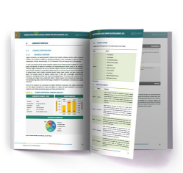 Cloud computing is an on-demand delivery of a virtual environment that includes pool of resources, such as compute, storage, applications, database, and network, through pay-as-you-go pricing service models which enable enterprises to host their workloads.
Cloud computing is an on-demand delivery of a virtual environment that includes pool of resources, such as compute, storage, applications, database, and network, through pay-as-you-go pricing service models which enable enterprises to host their workloads.
The cloud computing market is projected to grow to USD 832 billion by 2025, at a CAGR of 18%. The cloud computing market is an immensely lucrative market for cloud computing leaders, as several companies from diverse verticals are progressively adopting cloud computing services.
Increase in the adoption of hybrid cloud services is expected to drive the growth of Cloud Computing Market
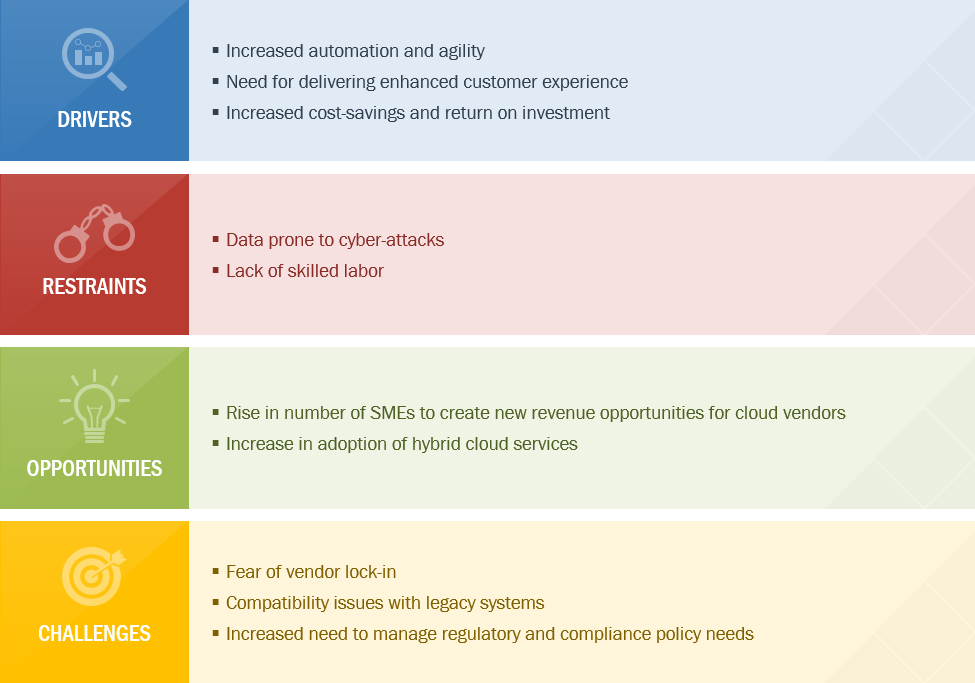
Cloud computing software quadrant report identifies and benchmarks Cloud computing Leaders such as Microsoft (US), AWS (US), Salesforce (US), Oracle (US), SAP (Germany) and Google (US) and evaluates them on the basis of business strategy excellence and strength of product portfolio within the Cloud Computing ecosystem, combining inputs from various industry experts, buyers, and vendors, and extensive secondary research including annual reports, company press releases, investor presentations, free and paid company databases. Top cloud computing companies are rated and positioned on 2x2 matrix, called as ‘Company Evaluation Quadrant’, and identified as Visionary Leaders, Dynamic Differentiators, Innovators, or Emerging companies.
Cloud computing software quadrant report identifies and benchmarks Top cloud computing companies such as AWS (US), Microsoft (US), Google (US), Alibaba (China), SAP (Germany), IBM (US), Oracle (US), VMware (US), Rackspace (US), Salesforce (US) and evaluates them on the basis of business strategy excellence and strength of product portfolio within the machine vision ecosystem, combining inputs from various industry experts, buyers, and vendors, and extensive secondary research including annual reports, company press releases, investor presentations, free and paid company databases. They are rated and positioned on 2x2 matrix, called as ‘Company Evaluation Quadrant’, and identified as Visionary Leaders ( Cloud Computing Leaders ), Dynamic Differentiators, Innovators, or Emerging companies.
SAMPLES:
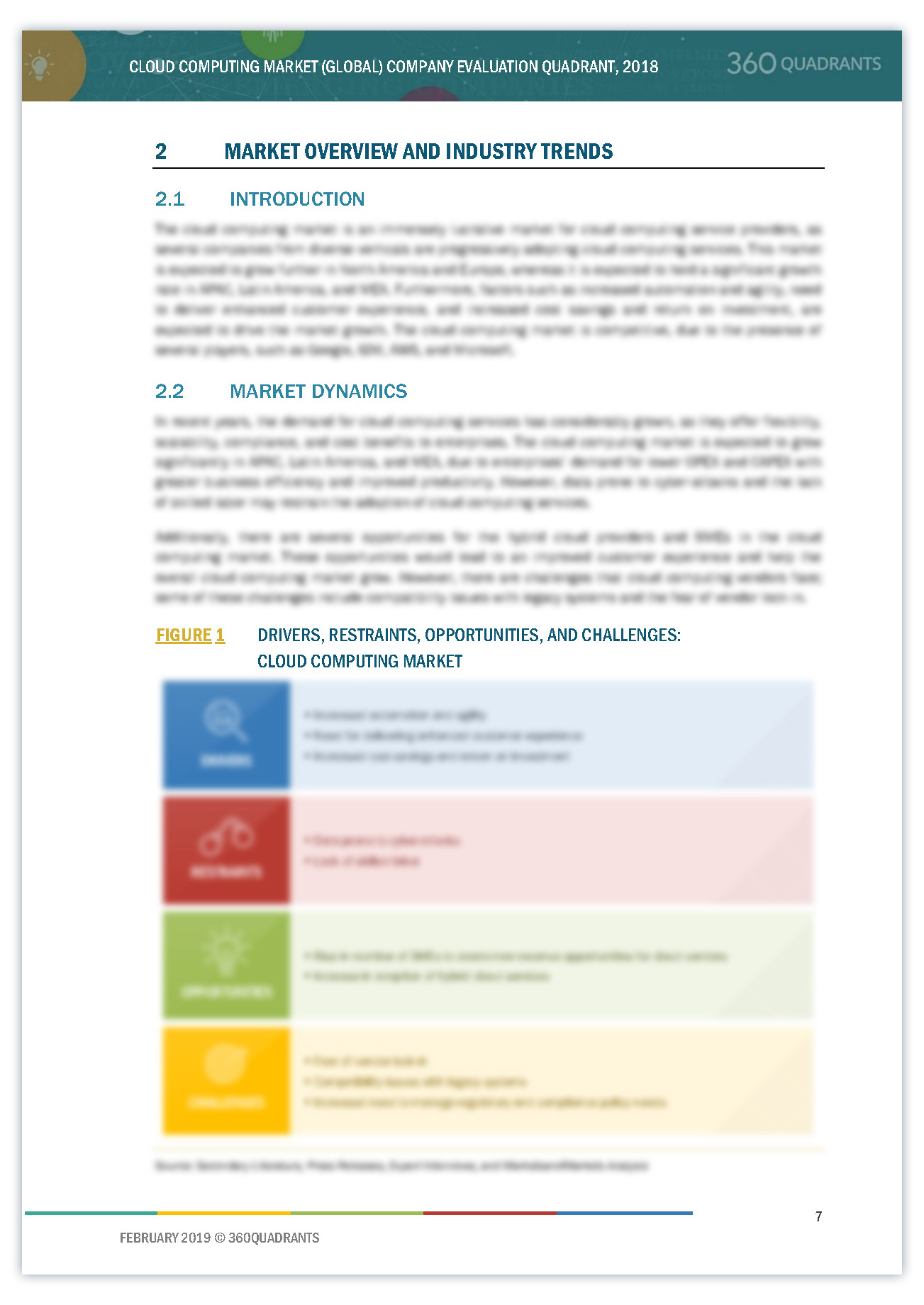
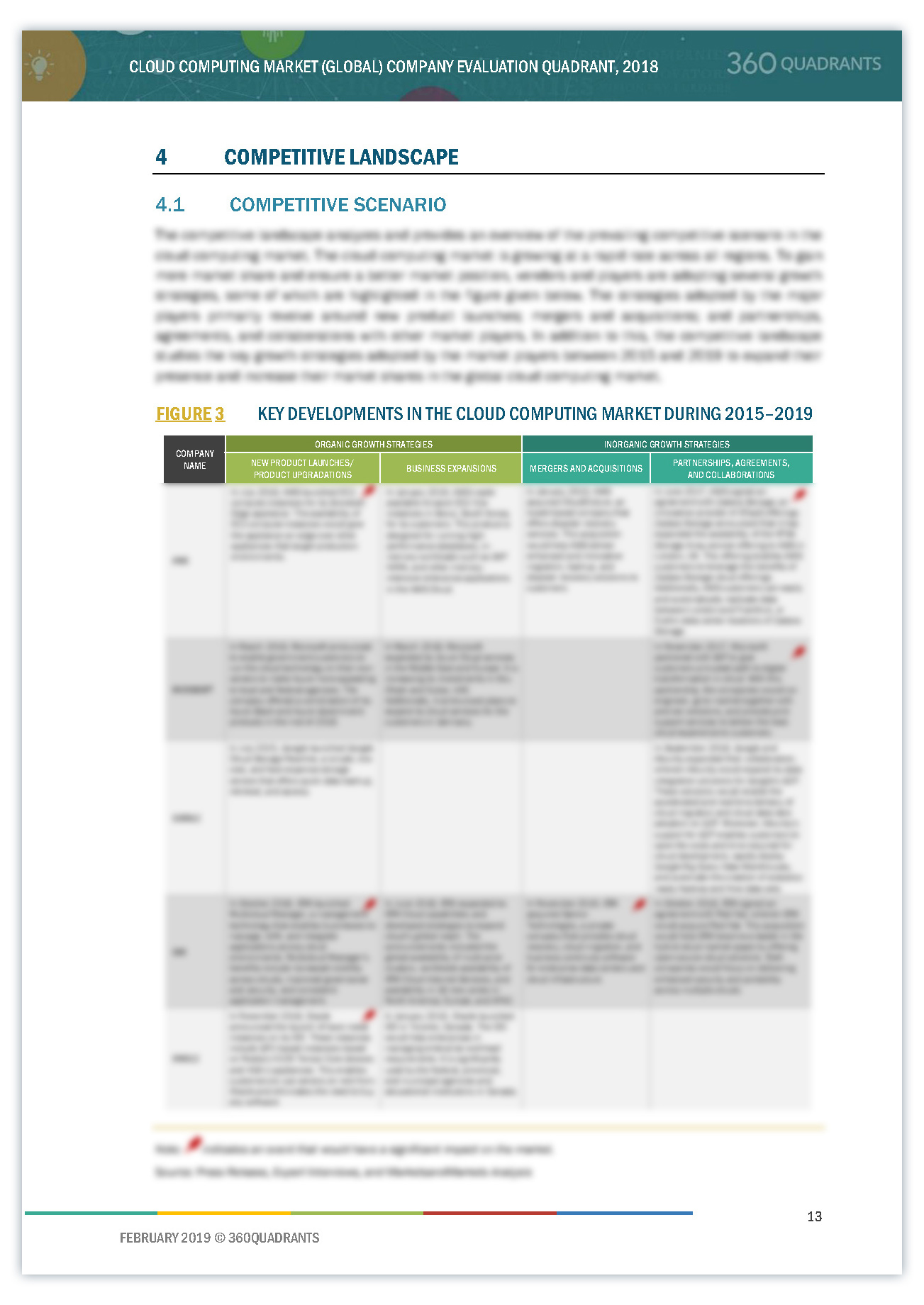
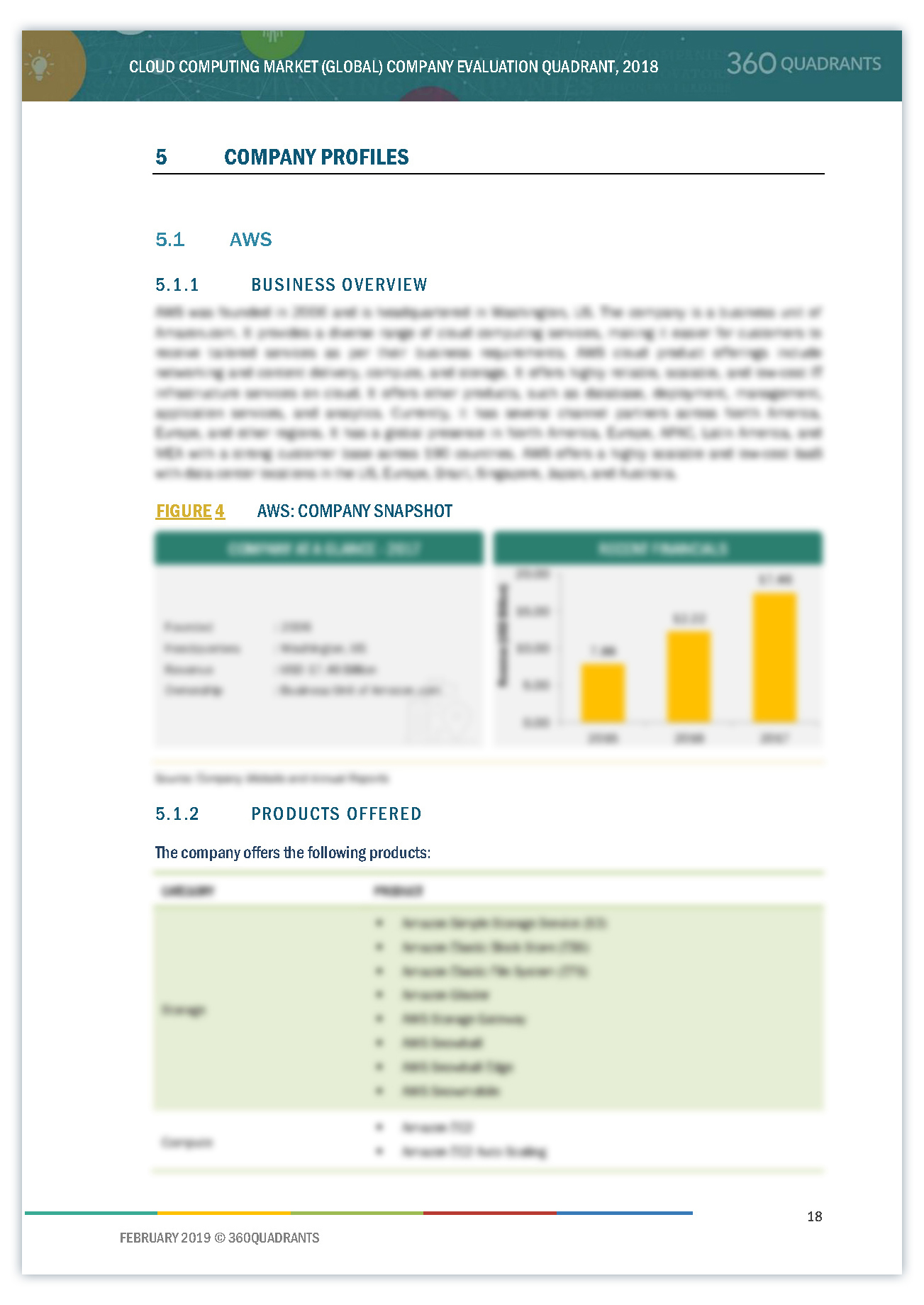
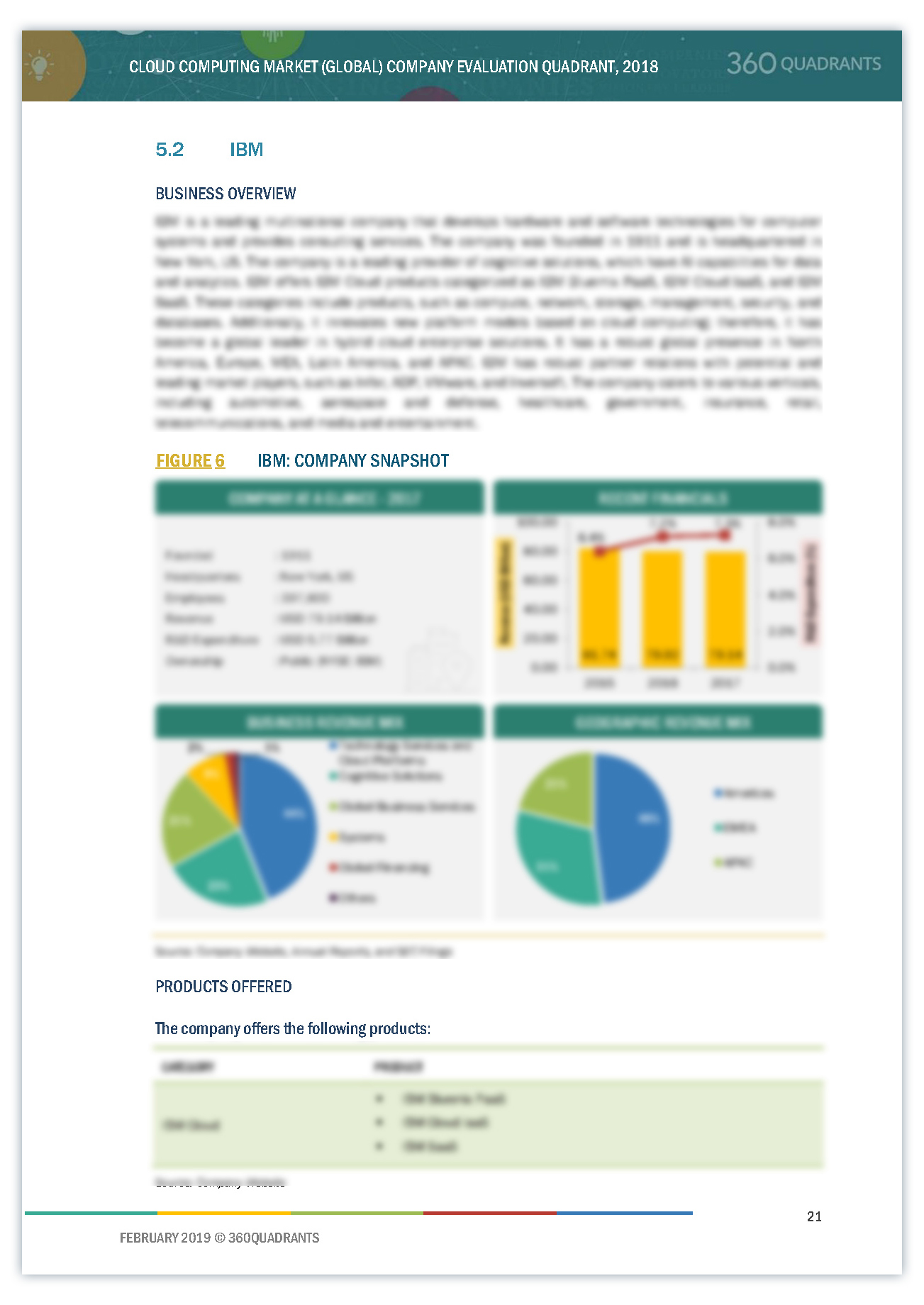
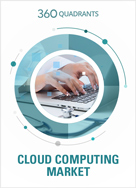
- Updated version of this Quadrant
- Different Company Evaluation Quadrant
- 'Startup Only' Company Evaluation Quadrant
- Region or Country specific evaluation
- Application or Industry specific evaluation ..Read More
- Submit a Briefing Request
- Question about our published research
- Request for evaluation of your organization for specific market
- Request for re-evaluation of Company Evaluation Quadrant ..Read More



